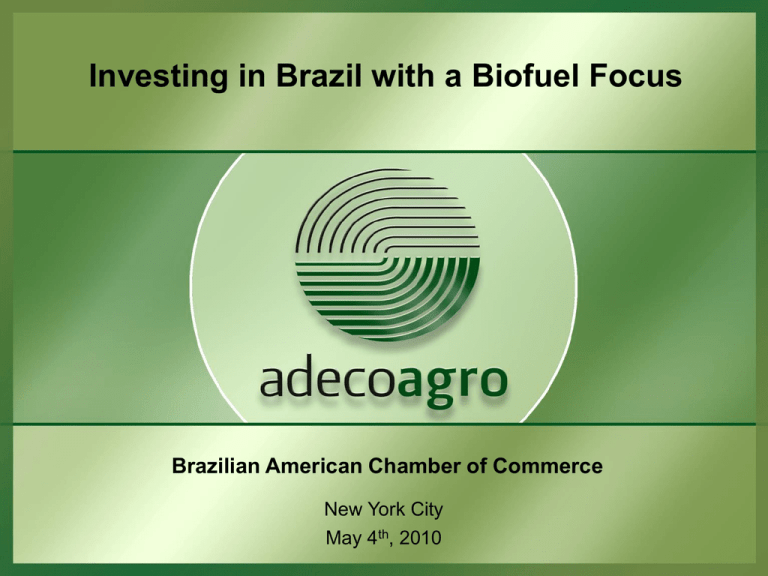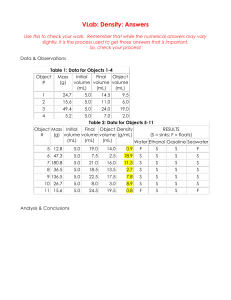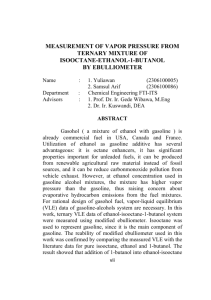Natural conditions - Brazilian American Chamber of Commerce, Inc.
advertisement

Investing in Brazil with a Biofuel Focus
Brazilian American Chamber of Commerce
New York City
May 4th, 2010
South America offers the most competitive conditions
for food & renewable sustainable production
South America Strengths
Natural conditions Human & Technology
Abundant water
Cutting edge Technology
Fertile soils
Mechanization
Mild temperature
Management skills
Land availability
Environmental sensitiveness
Economical
Geopolitical
Brazil and Argentina are Top
Food & Renewable Exporters
(sugar, ethanol, corn, soybean)
Low production cost Private land
Cheap land
Food surplus
Good infrastructure
No trade barriers
Vertical integration
Corporate farming
Good quality farmland is globally limited
Source: Atlas of Global development, World Bank, 2008
2
Biofuel can be globally produced without
decreasing land availability for crops
The right crop in the right place: changing from grassland into sugarcane
Millions of hectares (2007)
BRAZIL
851.2
TOTAL ARABLE LAND
354.8
1. Total Crop Land
76.7
Soybean
20.6
Corn
14.0
Powercane
7.8
Powercane for ethanol
Orange
1%
3.4
0.9
2. Pastures
172.3
3. Available area
105.8
Source: IBGE. Elaboration: UNICA.
There is room for Cattle to strongly increase its
efficiency (operational, crop productivity, feedlots)
3
Renewable energy and food can complementary be
produced without affecting food supply
High crop yields means higher
biofuel production per unit of land
Complementary production:
ethanol + sugar + bioelectricity
Yields (M3/hectare)
Powercane (Brazil)
Beet (EU)
Powercane (India)
Corn (USA)
Cassava (Thailand)
Wheat (EU)
0.0
2.0
4.0
6.0
8.0
Source: UNICA
10.0
Source: IEA ('05), Unica ('08)
Bioelectricity's Strengths
The higher crop productivity, the
higher biofuel production and
the better use of land
Synergy with hydro production (dry season)
Carbon Credit feasibility
Use of straw could increase its potential
4
Powercane is the most efficient and clean
feedstock for ethanol production
Energy Balance
Different Feedstocks Comparison
CORN
9.30
Agricultural operations
Transportation
Inputs: fertilizers, consumables,
seedlings, equipment
Total agricultural production
2.71
GHG Emissions Reduction
Energetic Balance (MJ/ha)
0.83
-30%
-83%
Processing Energy
Inputs: chemicals, lubricants, heat &
electric
Equipment, buildings, facilities
Total processing
Corn
Gasoline
1,083
2,897
4,012
4,107
10,849
14,829
9,988
18,107
-
31,055
1,976
33,031
1,653
379
2,032
Total energy consumption
47,860
20,139
Ethanol
Co-products (WDG, Bagasse)
Bioelectricity
92,253
36,803
-
165,863
15,154
7,129
129,056
188,146
81,196
2.7
16.4
168,007
9.3
54.9
Total energy production
Powercane
POWERCANE
Energy Balance
Energy Ratio
Portable Fuel Ratio
Source: IEA ('04), Unica ('08), Macedo, I ('04)
More important than the Energy Balance (heat) is the Portable Fuel Balance!
5
Best Practices as No Till should be applied to
achieve sustainable biofuel production
No-till Benefits
Improving water storage capacity
Water storage capacity (in/8 in)
Reduces erosion risk
Increases organic matter
Decreases use of pesticides
Improves soil fertility
Reduces CO2 emissions
Higher and stable yields &
lower costs year by year
.
Improves water efficiency
1.5
1.0
0.5
0.0
NO TILL
TILL
Decreasing pesticides usage
Decreasing fossil fuel usage
Carmen & Abolengo farms (Humid Pampas)
8,0
45
Spray/hectare
Spray per hectare
Liters per hectare
4,0
30
15
3,0
7,0
Liters/hectare
6,0
2,0
5,0
1,0
4,0
0
Convetional Tillage
Liters per hectare
60
No Till
-
No-till increases land productivity and returns over time
3,0
2003-04
2004-05
2005-06
2006-07
2007-08
6
The convenient Generation 2.5 of biofuels is already
on stage performed by efficient operations
A NEW MODERN MILL PROJECT REQUIRES 8 YEARS TO ACHIEVE FULL CAPACITY (BIOLOGICAL PROCESSES)
Sugarcane: Production & Area Evolution
60.0
5.0
Total Production (Tons)
4.5
4.0
K Hectares
50.0
40.0
3.5
Start Milling
3.0
30.0
20.0
2.5
2.0
Start
Planting
MM Tons
Total area (hectares)
1.5
1.0
0.5
10.0
-
Year 0
Year 1
Year 2
Year 3
Year 4
Year 5
Sugarcane = 75 tons
1 hectare of
Sugarcane (1)
Ethanol = 4.3 m3
Year 6
Year 7
Year 8
Need to integrate biofuels
industry around the world
Sugar = 4.1 tons
Power (2) = 4.5 MWh
(1) Includes replanting area; average of 7 years cycle; 60% ethanol – 40% sugar
(2) Does not consider use of straw
Infrastructure should be fixed
and suited for biofuels
7
US gasoline production cost for refineries
can be estimated as oil price x 1,05
What do US Consumers pay for on a Gallon of Regular Grade Gasoline?
The US national average retail price of a gallon of regular gasoline in February 2010 was $2.64. There are four
main components that make up the retail price of a gallon of gasoline:
10%
Distribution & Marketing
6%
Refining costs and profits – 6% of Gasoline price – 9% of oil price
(estimation 5% costs & 4% profit)
15%
Taxes: Federal, State, and local government taxes (not including county and local taxes)
accounted for about 15% of the national average retail price of regular gasoline in February
2010. Federal excise taxes were 18.4 cents per gallon and State excise taxes averaged 22.01
cents per gallon.
69%
$1,814
Crude Oil: The cost of crude oil as a share of the retail price varies over time and among
regions of the country. In February 2010, refiners paid an average of about $77 per barrel of
crude oil, which accounted for about 69% of the national average retail price of a gallon of
regular grade gasoline.
1 Barrel = 42 Gallons
$77 per barrel = 1,833 per Gallon
Cost 1 gallon of crude oil -1,833 ≈ 1,814 - Cost of crude oil in 1 Gallon of Gasoline
Cost of gasoline
for refineries
=
Oil Cost ≈
Oil Price
+
Refining cost =
5 % of Oil Cost
≈
Oil Price x 1,05
Source: U.S. Energy Information Administration
8
US could increase ethanol % on gasoline
without increasing gasoline price...
…nor paying subsidies (if oil price is over USD 85 per barrel). It only has to
eliminate Import Taxes on Brazilian Ethanol
Brazilian Anhydrous Ethanol
BRL / ton of
cane
Average cost of cane
Production
G&A
Energy net Revenue
Cash cost ex mill
Freight Brazil
39,68
10,54
2,69
-6,59
46,32
BRL / M3
469,83
124,84
31,86
-78,01
548,52
140,00
USD / M3
USD/
Gallon
USD/ Barrel
261,02
69,36
17,70
-43,34
304,73
77,78
39,63
422,14
142,10
0,988
0,263
0,067
-0,164
1,154
0,294
0,150
1,598
0,538
41,5
11,0
2,8
-6,9
48,4
12,4
6,3
67,1
22,6
Total cost without tax
564,23
2,136
89,7
US Import tax (1)
Total cost without tax
211,34
775,57
0,800
2,936
33,6
123,3
without tax
89,706
4,272
85,43
with tax
123,306
5,872
117,43
Freight Santos NY Harbor
Total cash cost
Return on investment
10%
Equivalent refined gasoline (USD / Barrel)
Refining cost
Equivalent oil (USD / Barrel)
Assumptions
Exchange rate
Pol
Yield of sugarcane
Industry efficiency
Liters per ton of sugarcane
1,8
14,50%
90
82%
84,45
Investment (USD / ton of sugarcane)
Return
(USD / ton of sugarcane)
Return
USD / M3 of ethanol
120
12
142,10
(1) US Import Tax fo r Brazilian Anhydrous Ethanol - US$ 0,54/Gallon + 25% of FOB value
When blending 15-20% of
ethanol, distilleries can still
produce the other outputs
from petroleum without
significant changes
9
E20 and E30 ethanol blends outperformed
gasoline in fuel economy tests (*)
KEY FINDINGS
1. Ethanol’s energy content was
not found to be a direct
predictor of fuel economy.
2. E20 and E30 ethanol blends
outperformed gasoline in fuel
economy tests for certain
autos.
3. Standard, non-flex-fuel vehicles
operated well on ethanol blends
beyond 10 percent.
4. Vehicle emissions met EPA
requirements and were
improved in key areas.
(*) Source: “OPTIMAL ETHANOL BLEND-LEVEL INVESTIGATION”
Researchers:
The University of North Dakota Energy & Environmental Research Center (EERC) & the Minnesota Center for
Automotive Research (MnCAR)
Testing Method:
The Highway Fuel Economy Test (HWFET), a test developed by the U.S. Environmental Protection Agency to
determine fuel economy
Vehicles Tested:
Toyota Camry (2.4 liter engine), Ford Fusion (2.3 liter engine), non-flex-fuel Chevrolet Impala (3.5 liter engine), flexfuel Chevrolet Impala (3.5 liter engine)
Fuels Tested:
Various blends of undenatured ethanol & Tier 2 gasoline
10
Adecoagro is already producing food and
renewable energy in Brazil
Cotton, Soy & Corn
La Pampa
13K HA
50K TONS
Coffee
1K HA
3.5K TONS
Ethanol, Sugar & Power
Buenos Aires
49K HA
259K TONS
Producing each commodity in the right location
After careful due diligence of different regions,
Mato Grosso do Sul was selected for expansion
Location Research Analysis
Analysis of different sites in Brazil
Proper environmental conditions:
Fertile Soils
Climate
Topography
Room for growth:
Few Neighboring mills
Competition with other crops
Underutilized pastures
Property size: small or large?
Logistics:
Rail link to port?
Regional terminal?
Future link to pipelines?
12
Angelica, our first ethanol Greenfield, was built in
16 months and began milling during August 2008
Angelica Mill
Cane reception
Boiler
Juice treatment
and Fermentation
Distillery and interconnections
Cooling towers and
Water treatment plant
13
Bahia offers excellent conditions to grow cotton, soy
and corn, with high potential for land transformation
Bahia’s Agro Ecological Features
Sunshine: 800 Kcal/cm2/day
Farms
Industry
Offices
Rains distribution: 1,800mm and an
extremely dry period
Temperature: Annual mean 23ºC
Bahia
Soils are deep and well drained
Even topography allows
mechanization
Skilled workers
Vertical Integration Strategy
Crop Rotation Scheme in Bahia
Year 1
Year 2
Soy
Corn
Year 3
Cotton
Year 4
Cotton
Bahia produces high quality
cotton at a very competitive cost
Acquire ginning capacity
Ginning process defines final
product quality:
Risk Management
Reduce Disease
Planting Flexibility
staple length uniformity
cotton purity
Increase crop margins
We have developed a team in Bahia qualified to execute our expansion plan
14
Our irrigated & fully mechanized coffee operation
differentiates us from other players
BAHIA’S OPTIMUM CONDITIONS
FOR SPECIALTY COFFEE PRODUCTION
No frosts
100% Irrigation
100% Mechanization
Quality grains
Stable Quality
High Productivity
Low cost
Adjusted Technology
Vertical Integration
Processing facilities at farms
3rd Party Volume Trading
Exports to Premium Markets
International Certifications
Adecoagro’s Coffee Highlights
Quality Control
No correlation with other crops
Strong Client Relationship
1.3K hectares in production
63,500 bags estimated harvest
15
Thank You!





